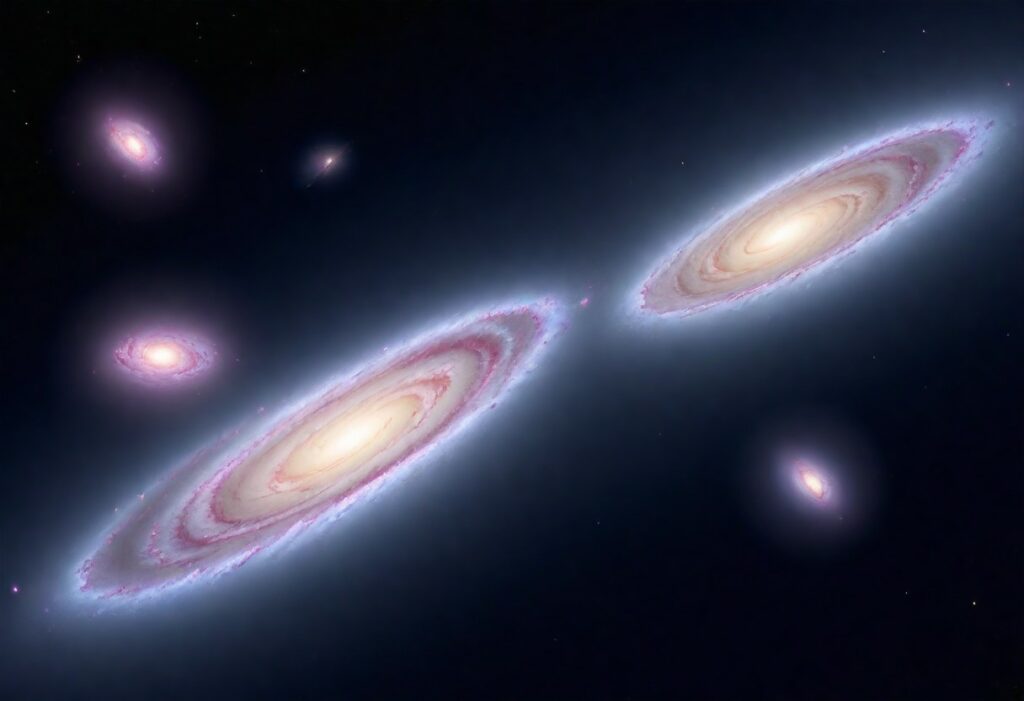The cosmos, with its vast expanse of galaxies, nebulae, and cosmic phenomena, has captivated human imagination for millennia. Through scientific inquiry and technological advancements, we have begun to unravel the intricate tapestry of the universe. In this article, we embark on a journey through space and time to explore the structure and evolution of galaxies and the cosmos, delving into the fundamental processes that shape the cosmos we inhabit.
The Structure of Galaxies:
Galaxies, the majestic celestial entities that dot the vast expanse of the universe, stand as the fundamental building blocks of cosmic structure. With their diverse array of forms and characteristics, galaxies offer a window into the intricate processes that govern the evolution of the cosmos. In this exploration, we delve into the structure of galaxies, unraveling their mysteries and understanding the forces that shape their existence.
Types of Galaxies
Galaxies come in a rich variety of shapes and sizes, each telling a unique story of cosmic evolution. Broadly classified into three main types—spiral, elliptical, and irregular—galaxies exhibit distinct structural features and evolutionary pathways.
Spiral Galaxies: Among the most iconic and visually striking galaxies are the spirals, characterized by their prominent spiral arm structure and central bulge. The Milky Way, our own galactic home, belongs to this category. Spiral galaxies harbor vast regions of gas and dust, where new stars are born in abundance. The spiral arms, composed of luminous young stars, trace out intricate patterns as they spiral outward from the galactic center. Within the central bulge, older stars and a supermassive black hole reside, exerting gravitational influence over the galactic disk.
Elliptical Galaxies: In stark contrast to the graceful spirals, elliptical galaxies present a smooth, ellipsoidal shape devoid of spiral arms. These galaxies are primarily composed of older stars, lacking the ongoing star formation activity characteristic of spirals. Elliptical galaxies are often found in regions of dense galaxy clusters, where gravitational interactions and mergers play a significant role in shaping their morphology. Their formation and evolution are closely tied to the dynamical processes within galaxy clusters, where galaxy-galaxy interactions are frequent.
Irregular Galaxies: Irregular galaxies defy the neat categorization of spirals and ellipticals, exhibiting chaotic and irregular shapes. These galaxies often result from gravitational interactions and mergers with neighboring galaxies, which disrupt their original structures. Irregular galaxies are more common in regions of lower galaxy density, where gravitational interactions are less frequent. Despite their irregular appearance, these galaxies can still host regions of active star formation and contain valuable insights into the dynamic processes shaping galactic evolution.
Galactic Components
At their core, galaxies are intricate systems composed of various components, each playing a crucial role in shaping their structure and dynamics.
Stars: Stars are the primary constituents of galaxies, formed through the gravitational collapse of molecular clouds within galactic disks. Galaxies host stars of varying ages, sizes, and compositions, reflecting the diverse conditions present within their stellar nurseries. The distribution and properties of stars within galaxies provide valuable clues about their formation history and evolutionary trajectory.
Interstellar Gas and Dust: Interstellar gas and dust pervade the vast regions between stars, serving as the raw materials for new star formation. Molecular clouds, composed primarily of hydrogen gas and dust grains, provide the dense environments necessary for the birth of stars. These clouds undergo gravitational collapse, leading to the formation of protostellar cores and eventually, fully-fledged stars. The interplay between interstellar gas, dust, and stellar feedback processes shapes the ongoing cycle of star formation within galaxies.
Dark Matter: Despite its elusive nature, dark matter constitutes the majority of the mass in galaxies and exerts gravitational influence on their dynamics. Dark matter is thought to form a halo-like structure surrounding the luminous components of galaxies, providing the gravitational scaffolding that holds galaxies together. The presence of dark matter affects the motions of stars and gas within galaxies, contributing to their stability and structural integrity. While dark matter remains invisible to traditional telescopic observations, its presence is inferred through its gravitational effects on visible matter.
Galactic Evolution
Galaxies evolve over cosmic time scales through a complex interplay of internal processes and external influences, sculpting their structures and shaping their destinies.
Mergers and Interactions: Galactic mergers and interactions play a pivotal role in the evolution of galaxies, triggering intense bursts of star formation and reshaping their structures. When galaxies come into close proximity, their gravitational attraction can lead to tidal forces that distort their shapes and trigger the formation of tidal tails and bridges of stars and gas. In some cases, galaxies may merge completely, forming larger, more massive galaxies through a process known as galactic cannibalism. These mergers and interactions redistribute the stellar populations and gas reservoirs within galaxies, influencing their subsequent evolution.
Star Formation and Feedback: The ongoing process of star formation shapes the evolution of galaxies, regulating their chemical enrichment, energy balance, and structural properties. In regions of active star formation, massive stars emit intense radiation and stellar winds, sculpting the surrounding interstellar medium and triggering further star formation. Supernova explosions, resulting from the deaths of massive stars, inject energy and momentum into the interstellar medium, driving galactic outflows of gas and enriching the surrounding environment with heavy elements. These feedback mechanisms play a crucial role in regulating the rate of star formation within galaxies and shaping their overall evolution.
Environmental Effects: The environment surrounding galaxies also influences their evolution, with galaxy clusters and cosmic filaments exerting gravitational influences on their structures and dynamics. In dense galaxy clusters, galaxies undergo frequent interactions and mergers, leading to the formation of massive elliptical galaxies at the cluster centers. In contrast, galaxies residing in the outskirts of clusters may experience less frequent interactions and retain their spiral or irregular morphologies. The distribution and properties of galaxies within their cosmic environment provide valuable insights into the processes driving galaxy formation and evolution.
In summary, the structure of galaxies offers a glimpse into the intricate tapestry of cosmic evolution. From the graceful spirals to the enigmatic ellipticals and irregulars, galaxies embody the diverse manifestations of cosmic processes operating over billions of years. By unraveling the mysteries of galactic structure and evolution, astronomers gain deeper insights into the origins and fate of the cosmos, forging a path towards a more profound understanding of the universe’s past, present, and future. As we continue to explore the cosmic landscape, galaxies stand as beacons of discovery, guiding us on a journey through the wonders of the cosmos.
The Cosmos at Large:
Beyond the realm of individual galaxies lies a vast and intricate cosmic tapestry, woven with phenomena and structures that offer profound insights into the origin and evolution of the universe itself. In this exploration, we delve into the mysteries of the cosmos, from the prevailing cosmological models to the cosmic microwave background and the intricate web of large-scale structures that span the universe.
Cosmological Models
At the heart of our understanding of the universe’s origin and evolution lies the prevailing cosmological model known as the Big Bang theory. According to this model, the universe began as a hot, dense singularity approximately 13.8 billion years ago and has been expanding ever since. The Big Bang theory provides a framework for understanding the universe’s large-scale structure, cosmic microwave background radiation, and the abundance of light elements.
Inflationary cosmology, an extension of the Big Bang theory, proposes that the universe underwent a rapid period of exponential expansion, known as cosmic inflation, shortly after the Big Bang. This inflationary phase is thought to have occurred within a fraction of a second, smoothing out the early universe’s density fluctuations and providing an explanation for its large-scale uniformity and structure. Inflationary cosmology offers a compelling explanation for the observed isotropy of the cosmic microwave background and the formation of cosmic structures.
Cosmic Microwave Background (CMB)
One of the most significant pieces of evidence supporting the Big Bang theory is the cosmic microwave background (CMB) radiation. The CMB is a faint glow of radiation that permeates the universe, originating from the hot, dense plasma that filled the cosmos approximately 380,000 years after the Big Bang. As the universe expanded and cooled, this primordial plasma transitioned into a neutral gas, allowing photons to travel freely through space.
The discovery of the CMB in 1965 by Arno Penzias and Robert Wilson provided crucial confirmation of the Big Bang theory and revolutionized our understanding of the universe’s early history. The CMB appears as a nearly uniform glow across the sky, with small temperature fluctuations, or anisotropies, providing valuable insights into the distribution of matter and energy in the early universe.
Anisotropies in the CMB offer a window into the universe’s infancy, revealing subtle variations in temperature that correspond to differences in the density of matter and radiation. These density fluctuations serve as the seeds of cosmic structure formation, giving rise to the galaxies, galaxy clusters, and cosmic filaments observed in the universe today. By analyzing the CMB’s anisotropies with high precision, cosmologists can reconstruct the early universe’s conditions and test theoretical models of cosmic evolution.
Large-Scale Structure
The universe exhibits a hierarchical structure of cosmic web, comprising filaments, voids, and galaxy clusters interconnected by gravitational interactions. At the largest scales, the cosmic web forms a vast network of interconnected structures that span the observable universe.
Galaxy clusters, the largest bound structures in the universe, serve as the nodes of the cosmic web, hosting hundreds to thousands of galaxies bound together by gravity. These massive structures are not only repositories of galaxies but also reservoirs of dark matter, whose gravitational influence shapes the distribution of galaxies and cosmic structures.
The cosmic web’s filamentary structure connects galaxy clusters and superclusters, forming the backbone of the universe’s large-scale structure. These filaments serve as conduits for the flow of matter and energy, facilitating the growth and evolution of galaxies over cosmic time scales.
Voids, on the other hand, are vast regions of space with relatively few galaxies and low matter density. These cosmic voids represent the underdense regions of the universe, where the gravitational pull of surrounding matter is insufficient to overcome the universe’s expansion. Despite their sparse nature, voids play a crucial role in shaping the cosmic web’s overall structure, influencing the distribution of galaxies and the flow of matter through the universe.
The cosmos presents a vast and intricate tapestry of cosmic phenomena and large-scale structures that offer profound insights into the universe’s origin and evolution. From the prevailing cosmological models to the cosmic microwave background and the cosmic web of large-scale structures, each aspect of the cosmos provides valuable clues about its history and fate.
As astronomers continue to explore the cosmos with ever-increasing precision and sophistication, new discoveries and insights into the universe’s mysteries await. By unraveling the secrets of cosmic phenomena and large-scale structures, we gain a deeper understanding of our place in the universe and the profound forces that shape its evolution. Through the collective efforts of scientists and researchers around the world, we embark on a journey of discovery, unveiling the wonders of the cosmos and unlocking the mysteries of the universe’s past, present, and future.
The study of the structure and evolution of galaxies and the cosmos embodies humanity’s relentless pursuit of knowledge and understanding. It reflects our innate curiosity about the universe and our place within it. Through meticulous observation, analysis, and theoretical modeling, astronomers and cosmologists endeavor to unravel the mysteries of cosmic phenomena, from the birth of stars to the formation of galaxies and the dynamics of the expanding universe.
As we delve deeper into the complexities of the cosmos, we gain profound insights into its origin, dynamics, and ultimate fate. Each discovery, whether it be the detection of distant galaxies, the observation of gravitational waves, or the analysis of the cosmic microwave background radiation, adds a new layer to our understanding of the universe’s grand tapestry. By piecing together the cosmic puzzle, we paint a clearer picture of the forces and processes that have shaped the cosmos over billions of years.
Yet, our quest for knowledge is far from over. With each answered question come new mysteries waiting to be explored. Through ongoing exploration and scientific inquiry, we push the boundaries of our understanding, uncovering hidden truths about the universe’s past, present, and future. Our journey of discovery not only enriches our collective knowledge but also inspires future generations to continue exploring the wonders of the cosmos, fueling humanity’s insatiable curiosity and thirst for discovery.










More Stories
Inside the Hormonal Symphony: Understanding the Endocrine System
Understanding Gallstones: Causes, Symptoms, and Treatment Options
Cells: The Foundation of Life